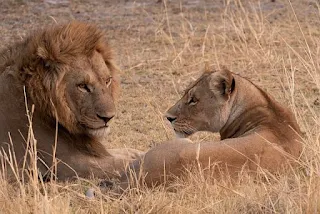The Lion kingdom
Introduction
The lion, known as the "king of the jungle," is a majestic and awe-inspiring creature that has captivated humans for centuries. With their regal manes, powerful roars, and graceful movements, lions are a symbol of strength, courage, and beauty. But beyond their majestic appearance, lions lead a fascinating life, full of social dynamics, hunting strategies, and adaptations to their environment.
Lions are large carnivorous mammals, with males weighing between 330-550 pounds and females weighing between 260-400 pounds. They have a short, tawny or golden coat, with a long mane that covers the head, neck, and shoulders. Their mane serves as a sign of masculinity and helps protect their neck during fights.
Lions inhabit the savannahs and grasslands of Africa and India, where they can find abundant prey and water. They live in prides, which are typically made up of several females, their cubs, and one or more males.
Lions are social animals, living in prides that are usually made up of:
- Females: Related females, often sisters or mothers, who form the core of the pride.
- Males: Males who have left their natal pride and joined a new one, often with other males.
- Cubs: Born after a gestation period of around 110 days, cubs are cared for by the entire pride
Lions are skilled hunters, using coordinated attacks to bring down prey. They feed on a variety of animals, including:
- Antelopes
- Zebras
- Wildebeests
- Buffaloes
- Small mammal
Lions have several adaptations that help them survive in their environment:
- Powerful legs and sharp claws for hunting and self-defense
- Excellent night vision, thanks to their reflective retinas
- Strong sense of smell and hearing
- Ability to go without water for long period
Lions are listed as vulnerable on the IUCN Red List, with their population declining due to:
- Habitat loss and fragmentation
- Human-wildlife conflict
- Poaching and trophy hunting
- Prey base decline
The life of lions is a testament to their strength, adaptability, and social complexity. As we continue to learn more about these magnificent creatures, we are reminded of the importance of conservation efforts to protect their habitats and ensure their survival for generations to come.
Lions are iconic creatures that evoke a sense of awe and wonder. Their majestic manes, powerful roars, and graceful movements have captivated humans for centuries. But beyond their regal appearance, lions are complex animals with unique social dynamics, hunting strategies, and adaptations to their environment.
Lions live in prides, which are typically made up of several females, their cubs, and one or more males. The females in a pride are usually related, and the males may come and go over time. This social structure is unique among cats, and it allows lions to cooperate and protect their territory.
Lions are skilled hunters, using coordinated attacks to bring down prey. They feed on a variety of animals, including antelopes, zebras, wildebeests, buffaloes, and small mammals. Their hunting strategy is based on stealth, speed, and teamwork, with each lion playing a crucial role in the hunt.
Lions have several adaptations that help them survive in their environment:
- Powerful legs and sharp claws for hunting and self-defense
- Excellent night vision, thanks to their reflective retinas
- Strong sense of smell and hearing
- Ability to go without water for long periods
Lions have been a symbol of power, strength, and courage for centuries. Their majestic appearance and regal demeanor have inspired countless works of art, literature, and film. In many cultures, lions are considered a symbol of royalty, and their image is used to represent authority and leadership.
Despite their majesty and importance in their ecosystems, lions are facing several threats to their survival. Habitat loss and fragmentation, human-wildlife conflict, poaching, and prey base decline are all major concerns. Conservation efforts are underway to protect lion habitats and ensure their survival for generations to come
The nature of lions is a testament to their majesty, sociality, and adaptability. These incredible animals have captivated humans for centuries, and their importance in their ecosystems cannot be overstated. As we continue to learn more about lions, we are reminded of the importance of conservation efforts to protect their habitats and ensure their survival.








Post a Comment